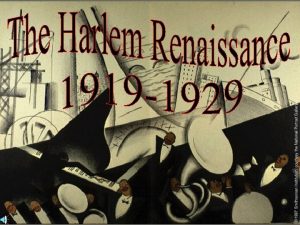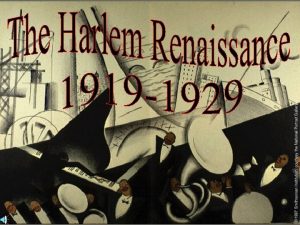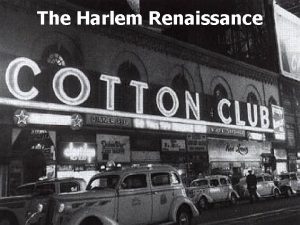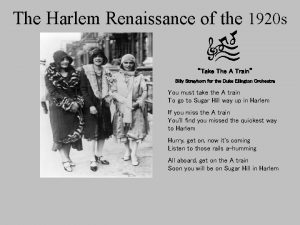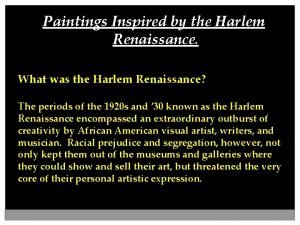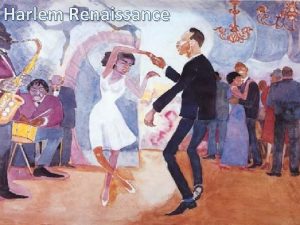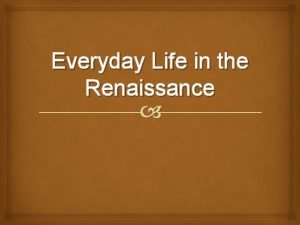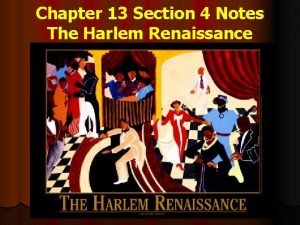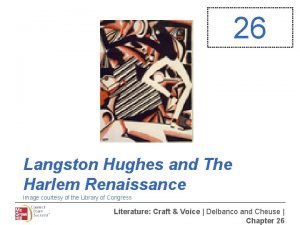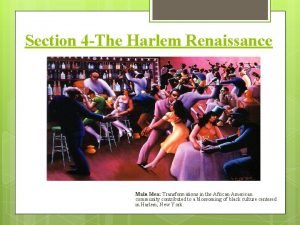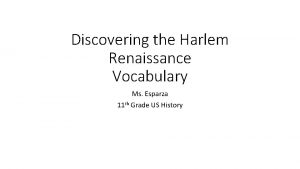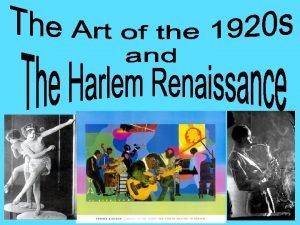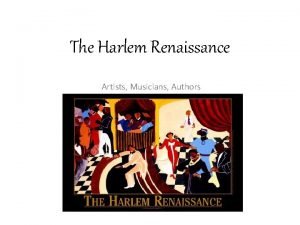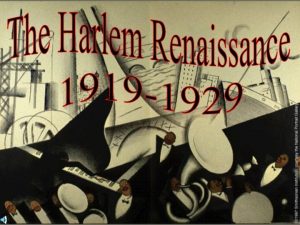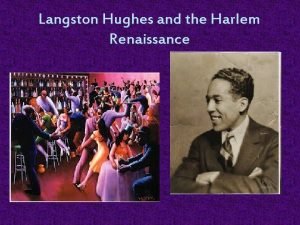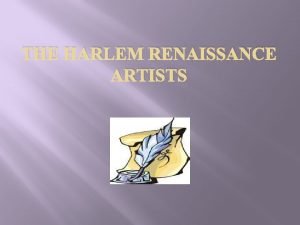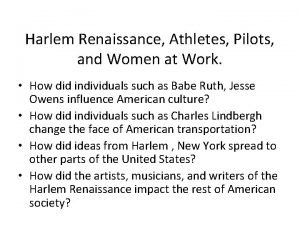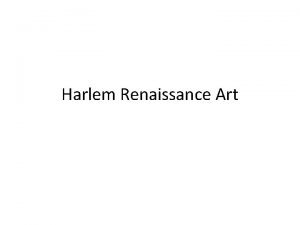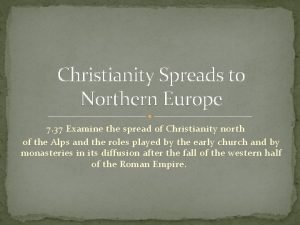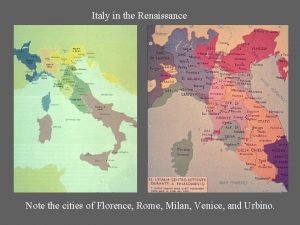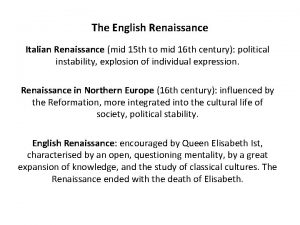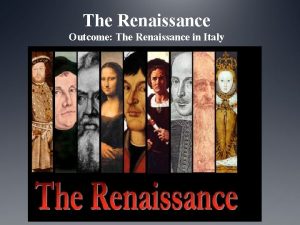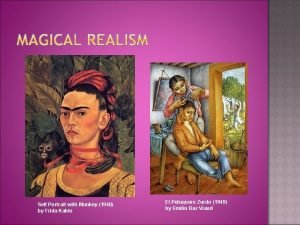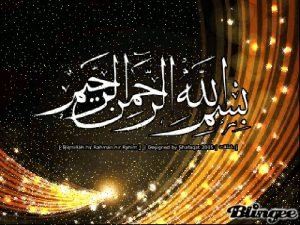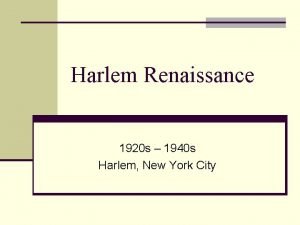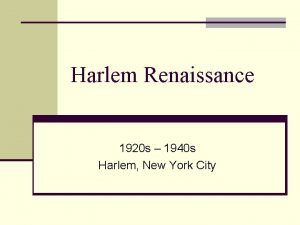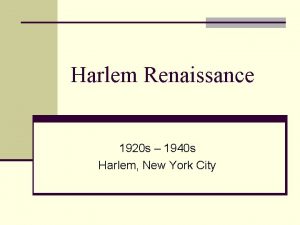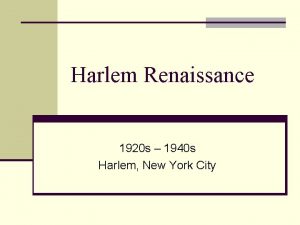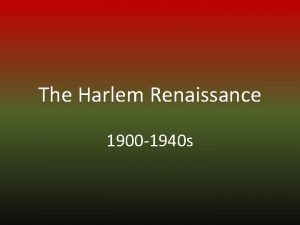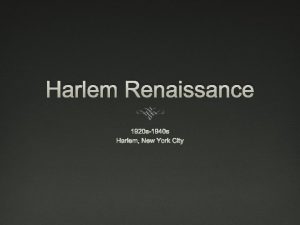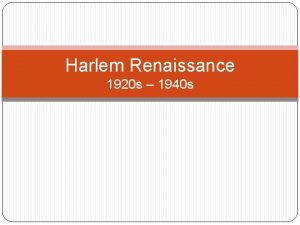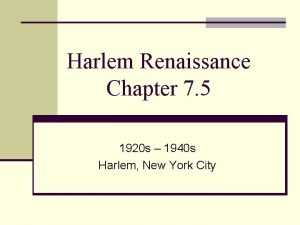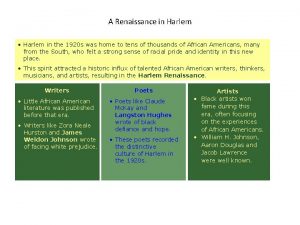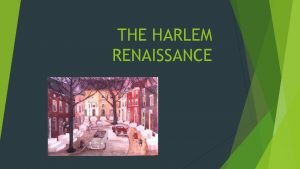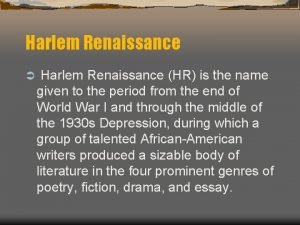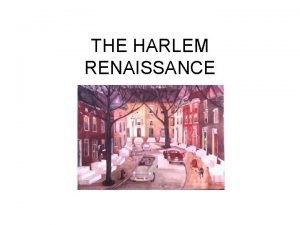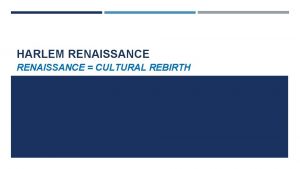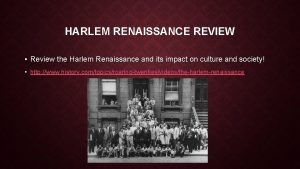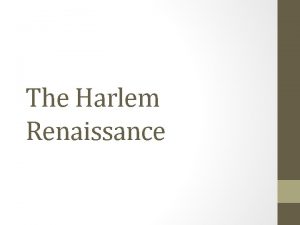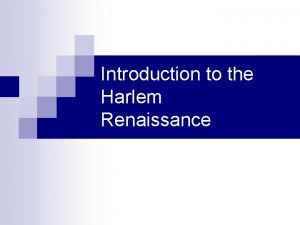Harlem Renaissance 1920 s 1940 s Harlem New





































- Slides: 37

Harlem Renaissance 1920 s – 1940 s Harlem, New York City

Overview n ren·ais·sance n A rebirth or revival n A revival of intellectual or artistic achievement and vigor n French, from Old French, from renaistre, to be born again n Source: The American Heritage® Dictionary of the English Language, Fourth Edition Copyright © 2000 by Houghton Mifflin Company.

Harlem Renaissance n originally called the New Negro Movement. n fostered a new black cultural identity. n 1920 s through mid-40 s. n an outpouring of creative expression that had long been bottled up by the constraints of segregation.

The Beginning n According to critic and teacher, Alain Locke, the Harlem Renaissance transformed “social disillusionment into racial pride”. n The Harlem Renaissance is primarily characterized as creative expression pertaining to literature, art, music, etc.

Authors and Works n Creative expression was one of the few avenues available to African Americans n Common bond: They dealt with African American life from an African American perspective. n African-American- owned magazines and newspapers flourished Countee Cullen (19031946) poet, novelist, playwright

1920 -1930’s America n In the years between World War I and the Great Depression, the United States saw a boom in the economy. n Jobs were plentiful in cities and many African Americans took advantage of the prosperity.

1920’s-1930’s America n Approximately 750, 000 African Americans moved North to more racially tolerant areas. Most migrating to urban areas. n Many moved to the Harlem section of Manhattan. The Harlem neighborhood had the highest concentration of African Americans in the world.

Harlem Renaissance Music n African Americans desired to break away from white suppression and focus completely on their place in society. The artistic movement of jazz music was used as a revolt against restraints.

Harlem Renaissance Music n The largest addition to music during the Renaissance came from the Negro spirituals. These century-old songs would eventually evolve into jazz. n Jazz was a form of music that allowed the musician to improvise and "have fun" with the music. Jazz became extremely popular and was featured in numerous clubs in Harlem.

Harlem Renaissance Music n One of the main reasons that jazz was so popular was that it allowed the performer to create the rhythm. n With this in mind, performers realized that there could not be any wrong way to play jazz. n Jazz's most typical instruments were the piano, string bass, and drums

Harlem Renaissance Musicians n Louis Armstrong n Josephine Baker n Duke Ellington n Dizzy Gillespie n Billie Holiday n Charlie Parker

Harlem Renaissance Art n African American painters and sculptors created bold, stylized works that showed scenes of black life from a variety of perspectives. The Janitor Who Paints by: Palmer Hayden (1937)

Harlem Renaissance Art n Palmer C. Hayden n Malvin Gray Johnson n Laura Wheeler Waring n Richard Barthe n Sargent Johnson n Augusta Savage Into Bondage by: Aaron Douglas (1936)

Harlem Renaissance Literature n The literature of the time period ranged in subject but race and racial identity remained common themes. n Authors used their literature as a means to protest against racial prejudice and also as a way to express pride in the distinctive cultural traditions of African Americans.

Harlem Renaissance Literature n Many African American authors also collected folk tales passed down through generations. n Many prose and poetry during the time period followed a rhythm much like the music of the era.

Harlem Renaissance Authors n Arna Wendell Bontemps n Countee Cullen n Langston Hughes n Zora Neale Hurston n James Weldon Johnson n Claude Mc. Kay n Jean Toomer n Nella Larsen

Videos n The Harlem Renaissance n The Rise of the Harlem Renaissance n Expression and Decline of the Harlem Renaissance n The Birth of Jazz

Edward Kennedy (Duke) Ellington (1899 -1974) composer, musician, band leader

Zora Neal Hurston (1891 - 1960) Writer, Folklorist, Anthropologist photo by Carl Van Vechten James Weldon Johnson (1871 -1938) writer, poet, statesman

The Great Migration n At the beginning of the period, particularly in the South, racism was rampant, and economic opportunities were scarce. At this time in the South, African Americans were restricted to "colored" facilities clearly inferior to those reserved for white citizens. Lynching was used to instill fear in entire African American communities in the South.

Causes of Migration n n new farm machinery drove thousands of tenant farmers off the land. 1915 - severe boll weevil infestation Southern states had fewer schools and higher rates of illiteracy than Northern states also had more cultural attractions and booming industries.

Boom Time? n n n The years between World War I and the Great Depression were "boom times" in the United States. A "boom" is a time of rapid, widespread expansion of economic opportunity, during which jobs are plentiful. Jobs were plentiful in cities, especially in the North.

Why Leave the South? n n n Between 1920 and 1930, almost 750, 000 African Americans left the South for political, social, and economic reasons. Why go North? n wider opportunities for prosperity n more racially tolerant environments n a sense of actual (as opposed to theoretical) citizenship Mass exodus from the South called The Great Migration.

Children in the Silent Protest Parade, 1917 Page from The Brownies Book, published by NAACP

Reaction of White Southerners n Promised better pay and improved treatment. n Intimidation n Some even boarded northbound trains to attack African American men and women in an attempt to return them forcibly to their homes.

The New Negro Has no Fear n After centuries of abuse in the South, many African Americans were "voting with their feet" UNIA Parade Organized in Harlem, 1924

The North: Home Sweet Home? n The North was a step up from the South, but it was no paradise. n Segregation in housing and hiring were the norm. n Northern racism sometimes took on a brutality that equaled anything in the South.

The North: Home Sweet Home? n New arrivals could land only low-paying jobs as janitors, elevator operators, domestics, and unskilled laborers. n Despite the challenges, most of those who went North never returned.

Why "Harlem" Renaissance? n Of the almost 750, 000 African Americans who moved North, nearly 175, 000 moved to Harlem. n Harlem is a section of Manhattan, which covers three square miles; therefore, Harlem became the largest concentration of black people in the world.

Triggers of Harlem Renaissance n the end of World War I and the return of black veterans n the formation of civil rights organizations (NAACP) and black solidarity movements (UNIA) n the ascendance of Harlem as the "Negro capital of the world" n a new sense of economic, social, and cultural potential

Famous Faces of the Harlem Renaissance Claude Mc. Kay “If We Must Die” “America” photo by James L. Allen

Famous Faces of the Harlem Renaissance Langston Hughes (1902 -1967) “Dreams” “Harlem” “The Weary Blues”

Lafayette Theatre opening night of Shakespeare's "Macbeth" n also known as the "House Beautiful“ n probably the first New York theater to desegregate n as early as 1912, African-American theatergoers were allowed to sit in orchestra seats instead of only the balcony.

New York Black Yankees, 1939 Photo credit: Morgan & Marvin Smith

Nella Larsen n April 13 -1891 -March 30 1964 n Nella Larsen went by various names throughout her life, including Nellie Walker, Nellye Larson, Nellie Larsen and, finally, Nella Larsen as well as by her married name Nella Larsen Imes. She was born in 1891 as Nellie Walker, the daughter of a Danish woman and an West Indian man of color. Her mother later married a white man. As a result, she grew up as the black child of a lower-middle class white household. Her family, perhaps ashamed of her race and anxious to get rid of her or perhaps interested in her education and future, enrolled her in Fisk University, a prestigious African-American school.

Nella Larsen n n 1926, having made friends with important figures in the Harlem Renaissance, Larsen gave up her work as a librarian and began to work as a writer active in the literary community. In 1927, she published Quicksand, a largely autobiographical novel, which received significant critical acclaim, if not great financial success. In 1928, she published Passing her second novel, which was also successful. In 1930, Larsen published "Sanctuary", a short story for which she was accused of plagiarism. Though the accusations turned out to be false, Larsen apparently never recovered from them and gave up writing.

Nella Larsen never wrote again, returning instead to nursing and disappearing from the literary circles in which she had travelled. Many of her old acquaintances speculated incorrectly that she, like some of her characters, had crossed the color line and disappeared.
 Map of harlem 1920s
Map of harlem 1920s Harlem map 1920s
Harlem map 1920s Bojangles morley
Bojangles morley Bessie smith harlem renaissance
Bessie smith harlem renaissance Harlem renaissance poems
Harlem renaissance poems Harlem renaissance drawings
Harlem renaissance drawings The harlem renaissance webquest
The harlem renaissance webquest Harlem renaissance began
Harlem renaissance began Daily life during the renaissance
Daily life during the renaissance Define harlem renaissance
Define harlem renaissance Harlem renaissance notes
Harlem renaissance notes Facts about the harlem renaissance
Facts about the harlem renaissance The harlem renaissance main idea
The harlem renaissance main idea Albric duer
Albric duer Harlem renaissance vocabulary
Harlem renaissance vocabulary Mastery connect/bubblesheet
Mastery connect/bubblesheet Harlem renaissance flappers
Harlem renaissance flappers Harlem renaissance
Harlem renaissance Harlem renaissance themes
Harlem renaissance themes Crash course harlem renaissance
Crash course harlem renaissance Harlem renaissance
Harlem renaissance Map of harlem renaissance
Map of harlem renaissance Harlem renaissance vocabulary
Harlem renaissance vocabulary Roaring 20s were characterized by
Roaring 20s were characterized by Harlem renaissance athletes
Harlem renaissance athletes Harlem renaissance art characteristics
Harlem renaissance art characteristics Outcome of renaissance
Outcome of renaissance Italian renaissance vs northern renaissance venn diagram
Italian renaissance vs northern renaissance venn diagram The renaissance outcome renaissance painters/sculptors
The renaissance outcome renaissance painters/sculptors Italian vs northern renaissance art
Italian vs northern renaissance art Last supper labeled
Last supper labeled The renaissance introduction to the renaissance answer key
The renaissance introduction to the renaissance answer key Italian renaissance vs english renaissance
Italian renaissance vs english renaissance The renaissance outcome the renaissance in italy
The renaissance outcome the renaissance in italy Self portrait with monkey 1940
Self portrait with monkey 1940 Que es una computadora
Que es una computadora Lahore resolution 1940 notes in urdu
Lahore resolution 1940 notes in urdu Edvac full form
Edvac full form
